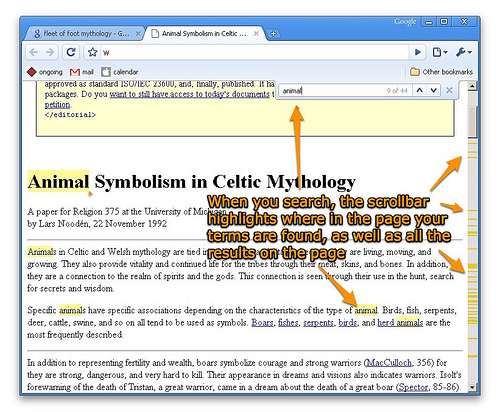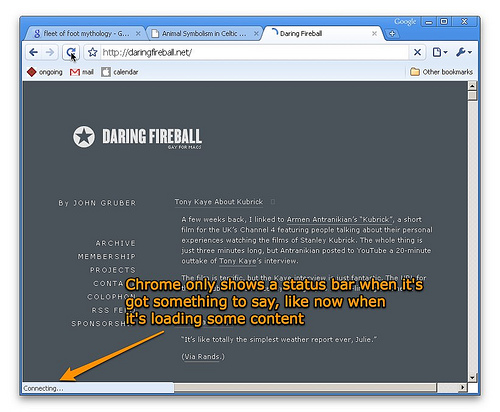Five Details of Google Chrome You May Have Missed
Google Chrome’s copyright notice implies the browser has been under development for two years. The long gestation period shows, as Chrome exhibits significant polish.
Chrome has a long list of sound technological choices beneath its polished exterior— I’ve yet to decide how many are truly new ideas —but the exterior is what has really caught my attention. The attention to detail would impress an Apple engineer; subtle animations and great pieces of UI detailing are present throughout the product.
These types of details are those that warm me to a product, they show above average care and impart a sense of craftsmanship. It’s hard to care for a product whose designers obviously didn’t.
I present a few I find especially endearing.
1. Find-in-page highlights locations of results in the scroll bar
Chrome tells you not just how many results there are, but where they are in the page. Programming IDEs have had this handy feature for a few years, but I’ve not seen it in a mainstream program before. If we’re lucky, Chrome will popularize the feature and we’ll see it in Word by, say, 2015.
2. Searching history includes page content
Calls for this feature have been heard in the halls of Firefox for years; hopefully it will come now Chrome has the feature. As to be expected from a Google product, search through history is lightening fast and available directly from Chrome’s homepage.
Rose and I were using a website to look for houses which didn’t put each houses address in the web page title. Chrome’s search inside the page made it super-easy to find houses via their street name when we wanted to look them up again, whether as Firefox was all at sea.
3. The status bar appears only when required
Most of the time the status bar sits superfluously at the base of one’s browser window, blank as the day it was born. Chrome displays its status bar only when there is something there to tell you about, the rest of the time remaining politely out of sight. One of my favourite details is the way the status bar shifts out of the way when you move the mouse toward it.
Firefox has an extension which approximates this behavior.
4. When you search a site, like Wikipedia, Chrome saves it to the omnibar and new tab page.
Chrome works hard to learn your habits and adapt itself to them. One of the less obvious ways this happens is when Chrome notices you’ve searched a site a few times.
5. Active textboxes are highlighted.
Chrome joins Firefox 3 and Safari by highlighting the active textbox. Even on Windows where this helpful behaviour is not customary; bravo.
Bonus Detail: Tab spinner indicates when it’s resolving the location of a page, then changes direction to indicate the page is loading. Probably the most subtle feature, but really helps when you’ve a slow proxy server to contend with.




